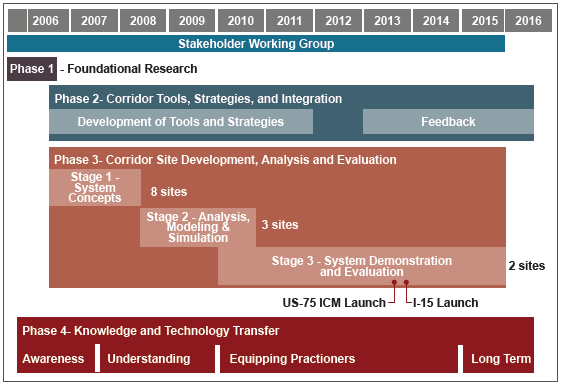Elements of Business Rules and Decision Support Systems within Integrated Corridor Management: Understanding the Intersection of These Three ComponentsAPPENDIX A: THE FOUR PHASES OF THE INTEGRATED CORRIDOR MANAGEMENT INITIATIVEThe four phases of the integrated corridor management (ICM) initiative according to Dion and Skabardonis (2015) is presented in this section. Figure 30 illustrates an overview of the ICM initiative phases. For further detail please refer to the San Diego I-15 Demonstration Integrated Corridor Management System PATH Report on Stage 3: Site Demonstration and Evaluation, which is the source of the information presented in this appendix. References cited from the original report are at the end of this section.  Figure 30. Diagram. U.S. Department of Transportation integrated corridor management initiative timeline. (Dion and Skabardonis, 2015, p. 7) PHASE 1: FOUNDATIONAL RESEARCHA key outcome of Phase 1 was the development of a generic concept of operations for ICM demonstrating how an ICM system could operate along a generic 15-mile corridor serving a central business district and consisting of freeway, arterials, bus, and rail networks. This document was developed to serve as a guidance resource for sites seeking to develop their own concepts. In addition to the concept of operations, a shared framework through which the ICM Initiative could identify, test, revise, and deploy appropriate technologies and techniques was developed, as well as early guidance on the steps needed to support the development, implementation, and operation of ICM systems. Key activities that were conducted during this phase include:
PHASE 2: CORRIDOR TOOLS, STRATEGIES, AND INTEGRATIONThe primary outcome of the phase was the development of validated and tested methodologies to support ICM system analyses to be conducted in Phase 3. Several of the developed tools were also subsequently used to support pre-deployment system evaluations in Stage 2 of Phase 3, and post-deployment evaluations in Stage 3 of Phase 3. Key activities conducted during Phase 2 of the initiative include:
PHASE 3: CORRIDOR SITE DEVELOPMENT, ANALYSIS, AND DEMONSTRATIONPhase 3 of the ICM initiative focused on the operational evaluations of ICM concepts through modeling and simulation, and system implementation. Activities within this phase were divided into three stages; concept development, AMS, and demonstration/evaluation, described in detail below: Stage 1: Concept DevelopmentDuring this stage, stakeholders from each of the selected pioneer sites were tasked with developing a concept of operations and preliminary system requirements for the ICM system they would be deploying on their respective corridors, using the generic concept of operations that was developed in Phase 1 of the initiative as a guide. Sample data from each site were also provided to the U.S. Department of Transportation (U.S. DOT) to assess data availability and the suitability of each proposed ICM corridor for conducting modeling and simulation evaluations. Each document first inventoried existing transportation systems and described the operational performance of these systems. Each document then identified the goals and objectives of the proposed ICM system, the strategies to be pursued for improving corridor operations, the user needs and asset requirements for the proposed system, how the system was envisioned to operate under various scenarios, and the eventual responsibilities of system stakeholders. The system requirements that were subsequently developed further identified and defined the different Intelligent Transportation System (ITS) components that would need to be integrated along each corridor. The resources for preparing a Concept of Operations is provided in Appendix B. Stage 2: Analysis, Modeling, and SimulationUnder this stage, the corridors were first modeled according to the analysis, modeling, and simulation (AMS) framework that was developed in Phase 2. For each corridor, key ICM strategies from the Concept of Operations developed in Stage I were then selected for modeling and analysis to assess the range of expected benefits associated with each proposed system. Table 1 lists the various management strategies that were modeled and evaluated for each corridor. Depending on the corridor, various combinations of strategies aimed at improving traveler information, traffic management, HOV/HOT operations, and transit management were considered. Stage 2 activities further resulted in the development of new tools for the analysis of freeway ramp metering, HOT lane operations, congestion pricing systems, transit operations, and active traffic management strategies. Activities also led to improved model calibration and data analysis methods.
More detail about Stage 2 is available in the San Diego I-15 Integrated Corridor Management (ICM) System: Stage II (Analysis, Modeling, and Simulation) report, which can be accessed at: https://merritt.cdlib.org/d/ark:%252F13030%252Fm5z039tp/2/producer%252FPRR-2010-09.pdf Stage 3: Demonstration and EvaluationThis stage, which was expected to last three to four years, consisted of the development, implementation, and operational evaluation of an actual ICM system on each corridor. A first goal was to demonstrate the application of institutional, operational, and technical integration approaches in the field. A second goal was to document the operational benefits associated with each system and the implementation issues encountered during system development and implementation to assist with future ICM system deployments along other corridors. The following nine tasks were defined for Stage 3 of the I-15 ICM Demonstration project:
Each of the above tasks are described in detail in the chapter 6.1 of the San Diego I-15 Demonstration Integrated Corridor Management System PATH Report on Stage 3: Site Demonstration and Evaluation report. On phase 3, specific activities associated with each deployment site included:
PHASE 4: INTEGRATED CORRIDOR MANAGEMENT OUTREACH AND KNOWLEDGE AND TECHNOLOGY TRANSFERThe goal of Phase 4 of the ICM Initiative was to equip corridor managers and operators around the country with a comprehensive resource set to help them develop, implement, and evaluate prospective ICM systems. Key outreach and technology transfer activities that were conducted during this phase include:
REFERENCES
| |||||||||||||||||||||||||||||||||||||||||||||||||||||||||||||||||||||||||||||||
|
United States Department of Transportation - Federal Highway Administration |
||